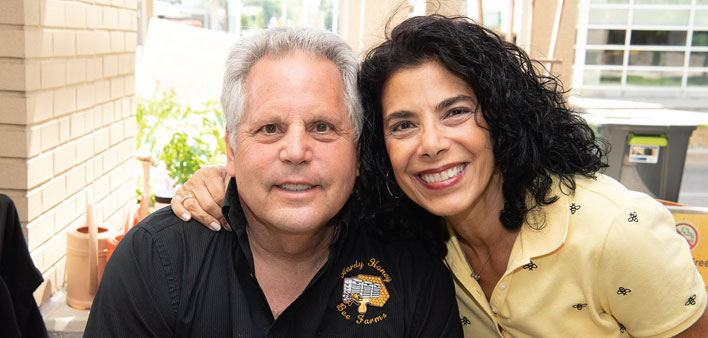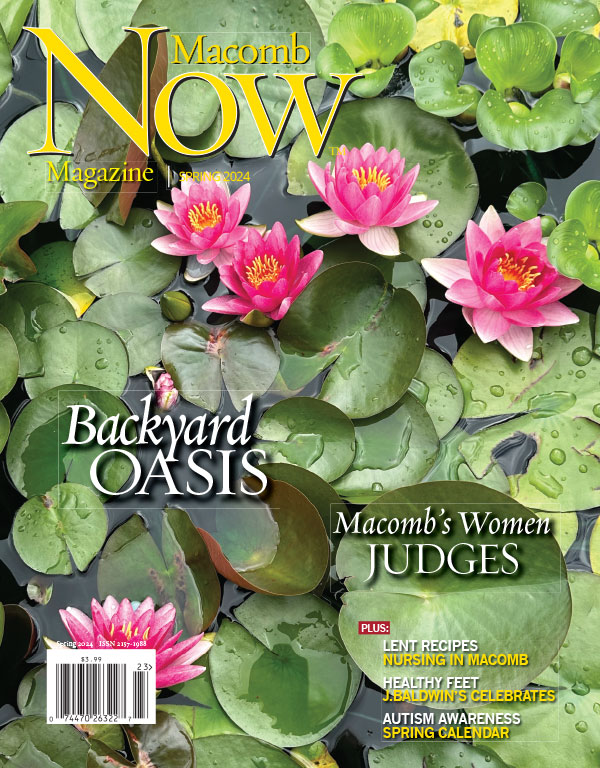Golden Deliciousness

By Rebecca Calappi / Photography by Mike Ferdinande
Whether you like a drizzle on your oatmeal in the morning, a spoonful as an afternoon pick-me-up or in a decadent dessert after dinner, honey is a go-to ingredient for any sweet tooth. The sugary goo can be found in varying shades from almost white to near black. “The darker the honey, the more antioxidants it has,” explained Carlo Daleo, beekeeper at Hardy Honey Bee Farms in Sterling Heights. But thinking of the honey often found at grocery stores, “Lighter honey is more marketable.” Daleo and his wife, Linda, have been migratory beekeepers for nearly ten years. A former groundskeeper for Warren Consolidated Schools, Daleo was injured and couldn’t return to his job. That’s when beekeeping buzzed into his life.
His dad raised honeybees, and after he passed away, he left some bees in Romeo. Daleo’s brother bought the property and asked if he wanted the hives. “That same day, I saw a flier from Schoolcraft College on beekeeping. That first day of class we opened the hives and it got addicting after that,” recalled Daleo.
Today, Hardy Honey Bee Farms of Sterling Heights has 480 hives in Washington, Romeo, Armada, St. Clair and Metamora. Just last year, their bees produced more than 14,000 pounds of honey. This year, they’re on track to double that amount. But honey is just the bonus of beekeeping. The real job is supplying bees to local farmers for pollination of their crops. Hardy Honey Bee Farms supplies bee colonies all year long traveling them south to Florida and west to California during our winter months. Since the queen bee is known to lay 2,000 eggs a day the colonies are continually replenishing, however they need to be tended to daily to ensure they stay healthy.
The Buzz On Honey
While the color of honey varies, so too does its taste. Depending on what plants the bees are pollinating, the honey can take on different flavors from the nectar. Clover is popular, as is sweet thistle. However, buckwheat, which is nearly black, has an earthy flavor, and as you’d expect from orange blossom, it takes on a citrusy, fresh taste. Generally, honey is lighter in color and has a sweeter flavor in the spring, and as the season progresses, the honey colors and flavors deepen and take on a richer taste.
Amanda Duemling is a registered dietitian with Beaumont Health. She says honey, “Helps with immunity and is loaded with antioxidants, minerals and vitamins. There’s also a naturally occurring hydrogen peroxide in it that helps heal cuts.”
It turns out, the old wives’ tale about honey soothing sore throats and easing coughs has some truth to it, too.
But remember, “Honey is a 100 percent natural sweetener. Table sugar has gone through a lot of processing,” explained Duemling. “Honey has more health benefits, while sugar just has sweetness and calories. A teaspoon of honey and a teaspoon of sugar have the same number of calories, so be careful to not consume too much in a day.”
The Keeping of Bees
With bees in the news, bee keeping and planting a bee-friendly garden is on trend. According to Jim Ford, beekeeper for Macomb Community College, anyone can help the bee population at home.
If keeping hives in your yard isn’t on your bucket list, consider planting a bee-friendly garden. According to Ford, plan your garden so there are blooms throughout the growing season. “The things we plant at the college are deer resistant wildflowers. We also have buckwheat, lavender, butterfly bush, rose of Sharon and flowering herbs such as sage and mint. Bees go crazy for mint,” said Ford.
Looking to try beekeeping as a hobby, Ford has some advice. “For a beginner, if you’re looking for a breed, an Italian bee is the friendliest, most docile bee you can get. They have great build up and great honey production,” he said.
“There’s several things you can get into: medicinal uses, relaxation, honey production and wax production,” Ford explained. “For a new person, take some classes or get with a beekeeper, so you know the whole process of beekeeping from start to finish.”
First year beekeepers take heed: you shouldn’t expect to get any honey in your primary year. “It’s great if the bees produce enough honey for the bees to use to eat for the winter,” explained Ford. “Going into your second year, your odds are greater to get five to 15 gallons of honey.”
However you enjoy the thick, golden liquid of nature, try different hues and sources for honey. Talk to beekeepers at farmers markets, or you can check in the with Macomb Community College Bee Club. It’s open to anyone with an interest in beekeeping.
MCC Bee Club – mccbeeclub.weebly.com Hardy Honey Bee Farms – hardyhoney.com.

